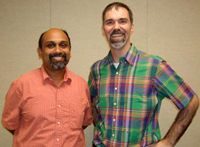October 19, 2011
Physics, psychology professors receive funding to study link between cognition, eye movements in context of physics problem solving

Sanjay Rebello, associate professor of physics and principal investigator, and Lester Loschky, associate professor of psychology and co-principal investigator, have received a grant from the National Science Foundation's Fostering Interdisciplinary Research on Education Division titled "Exploring Visual Cueing to Facilitate Problem Solving in Physics."
This three-year award began Oct. 1. The project builds on research done by physics doctoral student Adrian Madsen, and psychology doctoral student Adam Larson, under the guidance of Rebello and Loschky.
Vision is a critically important medium of communication. Students are continuously bombarded with images on television, cellphones and during instruction. Although well-designed images can facilitate learning, poorly designed images can hinder learning. This project tests the hypothesis that appropriately designed visual cues provided on physics problems, can improve students physics problem solving skills.
This project strengthens an existing partnership between a cognitive psychologist mentor and physics education researcher mentee to test the above hypothesis through a sequence of two studies with a total of 150 participants enrolled in introductory algebra-based physics courses. An expert panel of two cognitive psychologists, David Irwin and Brian Ross, and a physics education researcher, Jose Mestre, all of the University of Illinois-Urbana-Champaign, will serve as the advisory board and external evaluators.
This project is one of the first of its kind to explore and exploit the link between cognition and eye movements in the context of physics problem solving. Although this project focuses on problem solving in physics, the results of the research have implications for learning in other science, technology, engineering and mathematics disciplines where the use of images is important. Beyond its immediate scope, the project will benefit the field of physics education research by infusing ideas from cognitive psychology regarding visual cueing into physics education research, it will also potentially change the ways visual media are used in physics and other science, technology, engineering and mathematics instruction to more effectively facilitate students' learning.
The first study will identify differences in the eye movements of physics experts and novices while solving physics problems with diagrams. Participants will solve introductory physics problems, including diagrams whose spatial structure is intimately connected to their solution. This first study will use eye movement measures to test the hypothesis that experts focus on the relevant areas of diagrams, whereas novices tend to focus on the irrelevant areas. The second study will test the hypothesis that visual cueing can change where novices look in diagrams, and thereby improve their problem solving performance. Two graduate students, one each from physics and psychology, will be funded to work on this project under the guidance of the principal investigators.
